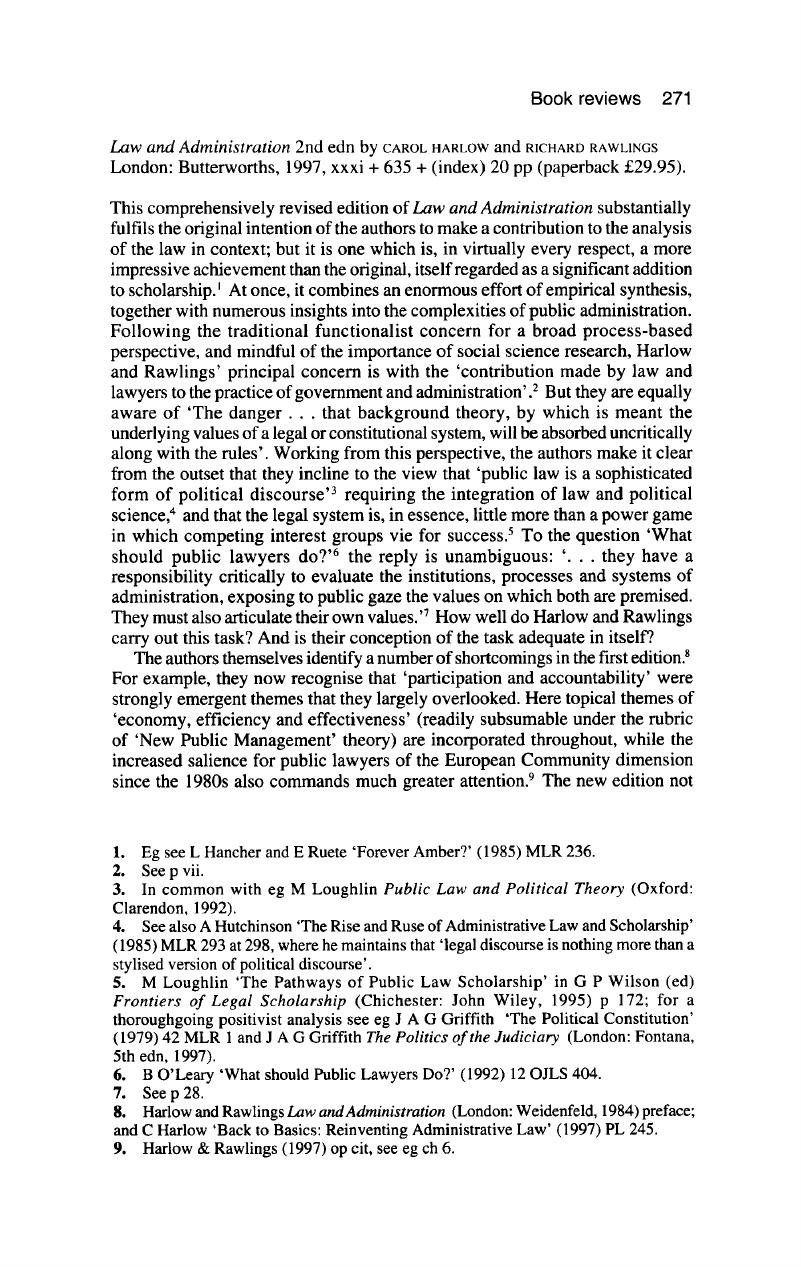No CrossRef data available.
Article contents
Law and Administration. 2nd edn by Carol Harlow and Richard Rawlings. London: Butterworths, 1997, xxxi + 635 + (index) 20 pp (paperback £29.95).
Published online by Cambridge University Press: 02 January 2018
Abstract

- Type
- Book Review
- Information
- Copyright
- Copyright © Society of Legal Scholars 1999
References
1. Eg see L Hancher and E Ruete ‘Forever Amber? (1985) MLR 236.
2. See p vii.
3. In common with eg M Loughlin Public Law and Political Theory (Oxford: Clarendon, 1992).
4. See also A Hutchinson ‘The Rise and Ruse of Administrative Law and Scholarship (1985) MLR 293 at 298, where he maintains that ’legal discourse is nothing more than a stylised version of political discourse.
5. M Loughlin ‘The Pathways of Public Law Scholarship in G P Wilson (ed) Frontiers of Legal Scholarship (Chichester: John Wiley, 1995) p 172; for a thoroughgoing positivist analysis see eg JAG Griffith ’The Political Constitution (1979) 42 MLR 1 and JAG Griffith The Politics of te Judiciary (London: Fontana, 5th edn, 1997).
6. B O'Leary ‘What should Public Lawyers Do? (1992) 12 OJLS 404.
7. See p 28.
8. Harlow and Rawlings Law and Administration (London: Weidenfeld, 1984) preface; and C Harlow ‘Back to Basics: Reinventing Administrative Law (1997) PL 245.
9. Harlow & Rawlings (1997) op cit, see eg ch 6.
10. See also eg M Loughlin above n 5, where he makes a distinction between different traditions of public law thought (see eg ch 7).
11. See p 128ff; and see N Lewis Choice and the Legal Order: Rising above Politics (London: Butterworths, 1996) for a broadly centre right analysis of these trends.
12. See p 131. For a strong defence of the social-democratic state, see eg B Kriegel The State & the Rule of Law (New Jersey: Princeton University Press, 1995); M Neocleous Administering Civil Society: Towards a Theory of State Power (London: Macmillan, 1996).
13. See p 149
14. See p 137.
15. See chs 8 and 9.
16. Quoted at p 210; see also M Freedland ‘Public Law and Private Finance – Placing the Private Finance Initiative in a Public Law Frame (1998) PL 288.
17. See p 211.
18. See p 295
19. See ch 11 for a detailed case study of OFTEL.
20. See p 317. See also T Prosser ‘Privatisation, Regulation and Public Services (1994) 1 Juridical Rev 3.
21. Seep 556.
22. J W F Allison A Continental Distinction in the Common Law: A Historical and Comparative Perspective on English Public Law (Oxford: Oxford University Press, 1996).
23. L Torchia ‘Developments in Italian Administrative Law in J Beatson and T Tridimas (eds) New Directions in European Public Law (Oxford: Hart Publishing, 1998) pp 139–141.
24. J W F Allison ‘Theoretical and Institutional Underpinnings of a Separate Administrative Law in M Taggart (ed) The Province of Administrative Law (Oxford: Hart Publishing, 1997) p 89.
25. J W F Allison above n 22, pp 39–40: See also N Bamforth (1996) PL 717.
26. See chs 16 and 17; the important procedural questions of natural justice and fairness are considered in ch 15.
27. Seep 111; and see eg H Hart The Concept of Law (Oxford: Clarendon, 1961).
28. See pp 101 and 107, eg the work of Davis, in particular, is examined in some detail both in relation to discretion and because of his ‘desire to open up administration… allowing citizens to participate in “a miniature democratic process” see K C Davis Discretionary Justice (Westport, Connecticut: Green word Press, 1969).
29. See p 530 and see L Bridges, G Meszaros and M Sunkin Judicial Review in Perspective (London: Cavendish, 2nd edn, 1995).
30. See p 575
31. Discovered by an analysis of case law; see eg R v Gloucestershire, ex p Barry (1997) 2 All ER 1; R v Secretary of the State for the Home Dept, ex p Brind (1991) AC 696; R v Ministry of Defence, exp Smith (1996) 1 All ER 257; R v SS for Foreign Affairs, ex p World Development Movement (1995) 1 All ER 611.
32. See pp 602–604.
33. See p 574.
34. See p 392ff.
35. See p 90.
36. See also C Harlow ‘Back to Basics: Reinventing Administrative Law (1997) PL 258.
37. See eg A Giddens Beyond Left and Right: the Future of Radical Politics (Cambridge: Polity Press, 1994).
38. W Hutton The State We're In (London: Verso, 1996) and W Hutton The State To Come (London: Verso 1997); see also Harlow (1997) above n 36, p 260.
39. W Scheuerman Between the Norm and the Exception: The Frankfurt School and the Rule of Law (Cambridge Mass: MIT Press, 1994) p 243; See in particular T W Adorno and M Horkheimer Dialectic of Enlightenment (London: Verso Press, 1979) and M Foucault Discipline and Punish: The Birth of the Prison (Harmondsworth: Penguin, 1977).
40. T Ertman Birth of the Leviathan: Building States and Regimes in Medieval and Modern Europe (Cambridge: Cambridge University Press, 1997).
41. J Habermas Between Facts and Norms: A Contribution to a Discourse Theory of Democracy (Cambridge Mass: MIT Press, 1996).
42. A Honneth The Struggle for Recognition: The Moral Grammar of Social Conflicts (Cambridge: Polity Press, 1995); See also J Alexander and M Pia Lara ‘Honneth's New Critical Theory of Recognition (1996) 220 New Left Review.
43. See eg F Bowring ‘Communitarianism and Morality: In Search of the Subject (1997) 222 New Left Review.
44. W Twining ‘Reflections on Law in Context in P Cane and J Stapleton (eds) Essays For Patrick Atiyah (Oxford: Clarendon Press, 1991).




